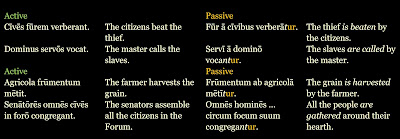Look at the following sentences and their translations
- Uter ex hīs sapiēns tibi vidētur? (Seneca) │ Which of these (two) men seems wise to you? [literally: is seen to you]
- Uter poēta ā plūribus legitur? │ Which poet is read by most?
- Cōpia frūmentī cōnficitur atque in reliquum annum servātur. │ A supply of grain is collected and (is) kept for the rest of the year.
- Omnia furōre tempestātis miscentur. │ All things are stirred up by the fury of the storm.
The verbs with
endings in bold are in the passive voice. Both in English and Latin, a
sentence can be active or passive, the two concepts are expressed differently
from one another.
A sentence can be [1] active or [2] passive
[1] active:
the subject of the sentence is performing the action:
The hunter catches the lion.
‘Hunter’ is the subject of the sentence and is performing the action = an active sentence; the verb ‘catches’ is active i.e. it refers to the person / thing performing the action
[2] passive:
The subject of the sentence is not performing the action but is experiencing an action performed by someone / something else which [i] may or [ii] may not be stated.
[i] The hunter is caught ¦ by the lion.
[ii] The hunter
is eaten.
Here, although ‘hunter’ is the grammatical subject of the sentences, it is not performing these actions but experiencing them; ‘is caught’ and ‘is eaten’ are passive
In English, this is expressed by the verb ‘to be’ + the past participle (e.g. ‘caught’; ‘eaten’). Latin sometimes does the same, but not in the present tense.
Image #1: A passive sentence can be expressed in any tense; we will look here only at the present passive, and in two stages.
Third person singular and plural: this is easy to conjugate since it is invariably formed by adding a distinctive -ur to the present tense of the verb regardless of conjugation. As in English, the passive verb still agrees with the grammatical subject of the sentence, not the person or thing performing the action. In the same way that the present active can translate either as a simple present or as a present progressive / continuous in English (he praises / he is praising), so too can the present passive (he is praised / he is being praised).
laudat │ he / she praises > laudātur │ he / she is (being) praised
laudant │ they praise > laudantur │ they are (being) praised
Active voice: Vēnātor leōnem capit. │ The hunter catches the lion.
> Passive voice: Leō ā vēnātōre capitur. │ The lion is caught by the hunter.
Active voice: Mīlitēs servōs capiunt. │ The soldiers catch the slaves.
> Passive voice: Servī ā mīlitibus capiuntur. │ The slaves are caught by the soldiers.
You now need to
recognise the terms ‘active’ and ‘passive’ to distinguish between the different
forms as these are used in the Latin grammars; look at the four pieces of
information that describe the verb:
laudat: he/she/ it praises / is praising │ [i] 3rd person [ii] singular [iii] present [iv] active
laudātur: he/she/it
is (being) praised │[i] 3rd person [ii] singular [iii] present [iv] passive
laudant: they praise
/ are praising │[i] 3rd person [ii] plural [iii] present [iv] active
laudantur: they
are (being) praised │[i] 3rd person [ii] plural [iii] present [iv] passive
Image #3: If, for example, you typed ‘laudātur’ into Wiktionary, it will give you, among others, the descriptions noted above and then lead you to the main page for that verb which list every form that verb has. Don’t be concerned about the reference to ‘indicative’ for the moment; that will be done later.



No comments:
Post a Comment